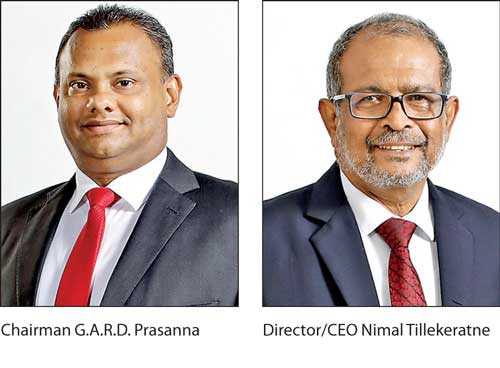Sunday Dec 07, 2025
Sunday Dec 07, 2025
Wednesday, 19 February 2020 02:13 - - {{hitsCtrl.values.hits}}
Pan Asia Banking Corporation PLC has ended 2019 Q4 with its best financial results ever, to report a Post Tax Profit of Rs.726.84 million during the final quarter, recording an impressive growth of 58% demonstrating its resilience amidst challenging conditions.
In a statement PABC said the bank’s operating profit before all taxes for the quarter increased by 78% reflecting strong growth in core banking activities and robust efforts in credit quality management.
The bank closed the FY 2019 with an operating profit before all taxes of Rs. 3,402.68 million, up by 31% which again is its best ever achievement despite less favourable macro-economic conditions and tight monetary and fiscal policies. 
The steeper increase in the taxes and levies on financial services of 58%, which include the Debt Repayment Levy (DRL) undermined the bank’s bottom-line to a great extent. This performance translated in to a Post-Tax Profit of Rs. 1,750.56 million in 2019, which is a 14% increase despite the sharp increase in taxes including DRL. Buoyed by the impressive profits, the Earnings per Share for the year 2019 rose to Rs. 3.96 cents from Rs. 3.48 share in the comparative period.
Supported by its superlative performance, the bank managed to increase its Return on Equity and Return on Assets (pre-tax) ratios to 14.5% and 1.52% in 2019 which now rank among the highest in the industry. These ratios stood at 13.73% and 1.28% respectively at the end of 2018. The bank’s Net Asset Value per Share as at 31 December 2019 increased to Rs.30.12, from Rs.25.41, a year before.
Despite the pressure on the margins due to deteriorating industry credit quality and the regulatory cap on the maximum interest rate for loans and advances that prevailed during 2019, the bank managed to maintain a healthy net interest margin of 4.36% which remained fairly unchanged from the previous year which is a commendable feat.
The bank’s gross loans and advances book witnessed a modest growth due to the slowdown in private sector credit growth seen across the industry. The bank’s gross loans and advances grew by 3.53% during 2019 to reach Rs. 117.50 billion as at 31 December 2019. Meanwhile, the bank’s deposit base grew by Rs. 3.92 b during the year to reach Rs. 122.54 b as at 31 December 2019.
The slow deposit growth of 3.3% was a result of the concerted efforts made by the bank to slow down the deposit mobilisation in view of slow demand for credit and also to purge certain large high cost time deposits in view of improving the net interest margin. Further as a result of the concerted efforts, the bank managed to improve CASA ratio by over 100 basis points in 2019.
PABC said 2019 was a year that saw the entire banking sector profit levels coming under pressure due to the substantial increases in both non-performing and under-performing credit, slowing down of the overall growth of credit to the private sector, narrowing margins and the weak macro-economic conditions.
Despite these headwinds, Pan Asia Bank managed to end the financial year with a gross non performing advances ratio of 6.31%, witnessing only a modest increase of 87 basis points since December 2018. In fact, the bank’s net non-performing advance ratio improved to 2.82% at the end of 2019 from 3.08%, a year before due to prudential provisioning which is a noteworthy achievement.
The bank managed to control impairment provisions in 2019, which resulted in individual impairment charges falling to Rs. 456.80 million, from Rs. 1,297.30 million a year ago. Total impairment charges for the quarter decreased by 104% on YOY basis supported by close monitoring of overdue credit portfolios and strong recovery efforts.
“Pan Asia Bank too had its fair share of the sector weaknesses, but yet again proved its mettle especially during the second half with higher earnings and setting stage for growth,” Pan Asia Bank Director and CEO Nimal R. Tillekeratne said.
“The proactive measures taken since mid-2018, has contributed to curtail deterioration in credit quality in comparison to the rest of the industry which witnessed a shocking growth in NPAs. As most of our challenges are now behind us, I believe the prevailing low interest rates and tax rates and the expected policy and political stability would provide the much needed tailwind for the industry to march ahead with much vigour,” Tillekeratne added.
The bank’s regulatory capital and liquidity ratios under BASEL III remain well above statutory minimums. The bank’s Common Equity Tier I Capital (CET 1), Tier I Capital (Tier 1) and Total Capital Adequacy ratios as at 31 December 2019 stood at 12.87%, 12.87% and 14.31% respectively. The bank’s Liquidity Coverage Ratios in Sri Lankan Rupees and all currencies as at 31 December 2019 stood at 128.84% and 165.02% respectively.
In addition to its record breaking financial performance, Pan Asia Bank also played a pivotal role in making a positive impact in the sphere of sustainability in 2019. This saw the bank which is a pioneer promoter in green financing in Sri Lanka being awarded with the prestigious ‘Global Climate Partnership Award’ by The Global Climate Partnership Fund (GCPF), one of the world’s largest climate funds which recognises outstanding performance and impact across categories such as capacities and skills, institutional capacities and green lending offerings, as well as outstanding energy efficiency or renewable energy projects.